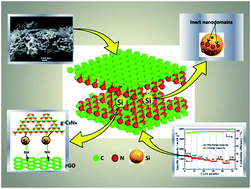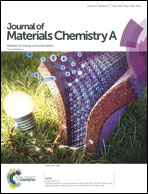Ultra-long life Si@rGO/g-C3N4 with a multiply synergetic effect as an anode material for lithium-ion batteries†
Abstract
Remarkable volume changes (>300%) and poor electrical conductivity hinder the commercial application of silicon in lithium ion batteries despite the fact that it delivers a high theoretic capacity of 4200 mA h g−1. Thus, a novel Si@rGO/g-C3N4 hybrid with a 3D porous sandwiched architecture, where silicon nanoparticles are anchored uniformly onto a rGO/g-C3N4 hybrid matrix via interface chemical bonding, is synthesized by a facile combined method of template-free self-assembly and heat-treatment. This sandwiched Si@rGO/g-C3N4 hybrid anode material exhibits a high reversible capacity of 1354.8 mA h g−1 at 0.1C and an ultra-long cycle life of 1000 cycles at 0.5C. A capacity loss of only 0.019% per cycle at 0.5C is achieved with a coulombic efficiency of 99.8%, even after 1000 cycles. The outstanding cycling performance could be attributed to the interface bonding between the surface Si NPs (silicon nanoparticles) and N-doped rGO/g-C3N4, which not only creates inert domains for controllable lithium ion intercalation, but also configures a relatively stable mechanical structure on cycling. The reported approach provides a viable strategy to synthesise ultra-long-life silicon anode materials.



 Please wait while we load your content...
Please wait while we load your content...